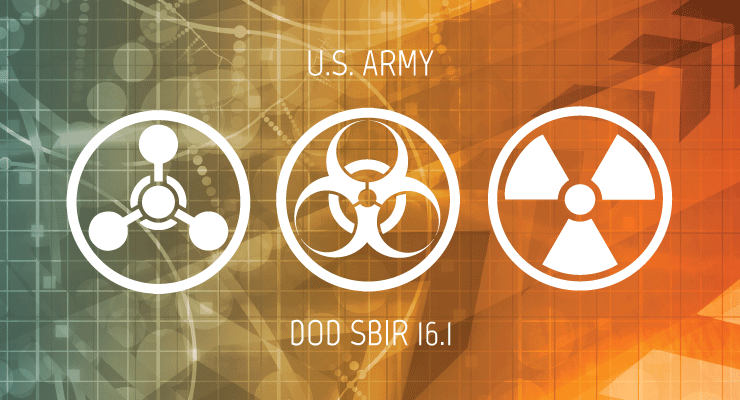The U.S. Army has released new topics for potential funding via the Department of Defense FY2016 Small Business Innovation Research (SBIR) program.
Focus areas related to Chemical, Biological, Radiological and Nuclear (CBRN) defense or biotechnology applications include:
On-Demand Cell and Tissue Biologics for Mass Casualty Response
On and off the battlefield, mass casualty events involving radiation exposure, chemical or biological agents, and explosive or incendiary devices can create a diverse range of injuries requiring both urgent and continuing care. Mass casualty events place enormous logistical strain on medical infrastructure, overwhelming personnel and rapidly depleting available medical supplies. This necessitates the stockpiling of medical supplies and therapeutics for on-demand use in the event of a healthcare surge.
A capability is sought to ensure off-the-shelf, large volumes of stockpiled cell and tissue biologics that would be in high demand following a mass casualty event in military theaters of operation, in humanitarian response operations, or events on the homeland.
Particulate Delivery System for Next-Generation Malaria Vaccine
An efficacious vaccine remains the most cost-effective means for the prevention of morbidity, mortality, and for the reduction of malaria transmission. Recent successes in vaccine development have demonstrated that efficacy of immune responses can be achieved through the use of viral-like particle (VLP)-linked immunogens.
The goal of this solicitation is to evaluate the potential of recombinant particulate (self-assembling nanoparticles, capsid surface particles, bacteria membrane-coated nanoparticles, outer-membrane vesicles, VLPs, etc.) delivery systems capable of displaying malarial antigens while retaining their capacity to form self-assembling structures.
Phase I proposals should demonstrate the capability to produce properly assembled VLPs that display specific malarial antigens and secondarily, can display heterologous adjuvant moiety on their surfaces.
High Pressure Resistant, Non-Powered, Flexible Chemical/Biological Protective Closure System
A need currently exists to develop a vapor tight closure that can withstand pressures experienced during normal military air transportation methods. Applications include collective protection systems, inflatable structures, vestibule attachments, individual protection garments, packaging of human remains and air transportation of sick individuals.
The closure system should be resistant to chemical and biological agents; able to be decontaminated by normal military decontamination techniques; not require power to operate; and have the ability to be used in austere (UV, sand, wind, hot, cold, etc) environments.
Biomedical Research and Development
Additional topics in biotechnology, biomedical solutions and combat casualty care include:
- Conservation and Maintenance of Trauma Injured Tissues for Autologous Repair and Reconstruction
- Semi-Autonomous Airway Management Device
- Secure Wireless Disposable Pulse Oximeter Patch that Generates a PPG Waveform
- Miniature, Point-Of-Care Device for Establishing Sterile Connections in Combat Environments
- Portable Occult Hemorrhage Detector and Resuscitation System
- Enabling Studies for Development of a Novel Therapeutic Agent for the Treatment of
- Combat-Related Posttraumatic Stress Disorder
- Device Solution to Enhance Vascular Access by Reducing Pain
- Effective Targeted Treatment of Peripheral Neuropathy
- Biofidelic Headform for Evaluation of Head Protection Against Blast, Sound and Blunt Trauma Threats
The Army will begin accepting proposals on January 11, 2016. Further details are available via Solicitation Number: DOD-SBIR-16-1(541712) and at the DoD SBIR/STTR Small Business Portal. The proposal response deadline is February 17, 2016.



